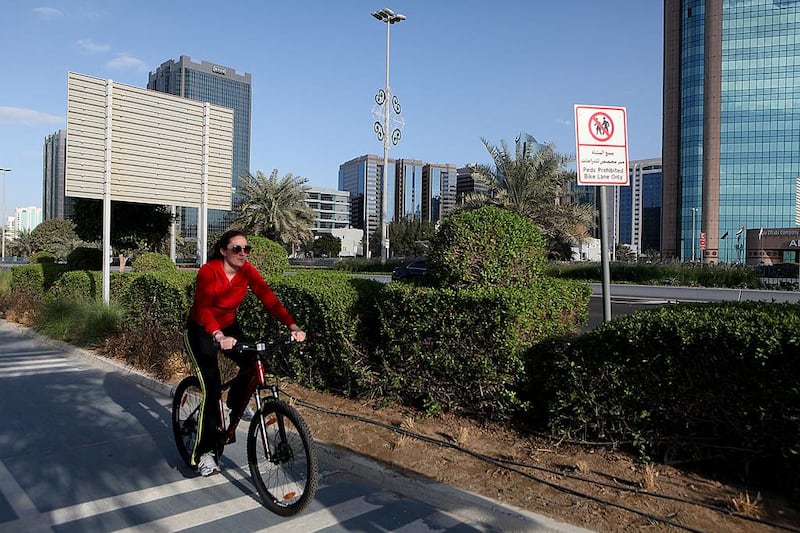ABU DHABI // The Department of Transport has unveiled a plan to make the emirate safer and encourage residents to walk or cycle by doubling the number of dedicated paths by 2020.
The Walking and Cycling Master Plan, released Tuesday, would ensure residents could travel in a healthier way than driving.
“We know how beneficial walking and cycling are, not only to the health and well-being of the public but also to the environment as they create little to no emissions,” said Abdullah Al Mehairbi, the head of public transport planning.
“The public will be provided with shaded walkways, safe crossing points, and walking and cycling routes and facilities, especially in the commercial and central areas of Abu Dhabi, Al Ain, and Al Gharbia.”
But a change in attitudes towards exercise and outdoor activities is essential for Abu Dhabi to become more pedestrian and bike-friendly.
Encouraging people to think about alternatives to cars from a young age was the most important aspect of the plan, said Saeed Al Hameli, the department’s executive director for surface transport.
“Without a doubt the infrastructure for encouraging walking and biking is important but they must be utilised and awareness is crucial in promoting these activities,” Mr Al Hameli said. “This is why we must focus on the young and educate them on how to be active.”
The department says a third of all inner-city journeys cover less than 3 kilometres, and a sixth under 1km – just a short walk or cycle.
It was assisted in the master plan by Abu Dhabi Police, the municipality, Urban Planning Council and Health Authority.
Mr Al Mehairbi admitted there were many improvements needed in infrastructure.
They include a lack of bicycle racks, high-speed sliproads for cars, narrow medians, motorways with poor pedestrian crossings, and few provisions for the disabled.
Officials say these challenges will be overcome and plan to develop projects similar to those on Abu Dhabi’s Corniche and the Bainunah waterfront in Al Bateen.
These will be complemented by elevated crossings for pedestrians and cyclists, and more walking and bike paths by 2020.
Although the first stages of the plan will focus on the central business district in the north of Abu Dhabi Island, it will also take in residential areas such as Khalifa City, Shahama and Baniyas.
Suhaib Al Marzouqi, a senior geographic information systems specialist at the department, said extensive studies had been done to ensure the needs of the public were considered at every step of the process.
“We did studies, abroad and here, analysing other cities transportation networks, as well as asking those across the emirate what they needed and wanted in terms of walking and cycling,” Mr Al Marzouqi said.
“We have since approached hotels and shopping malls asking them to encourage cycling and have provided them with bicycles, bicycle parking and bicycle maps to use.”
He said the department held bicycle days in schools to show students how to maintain their bikes and use them safely around the city.
tsubaihi@thenational.ae





